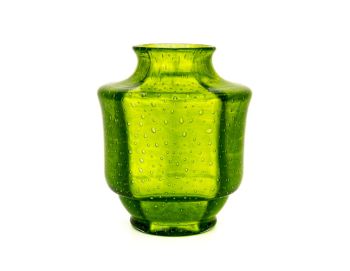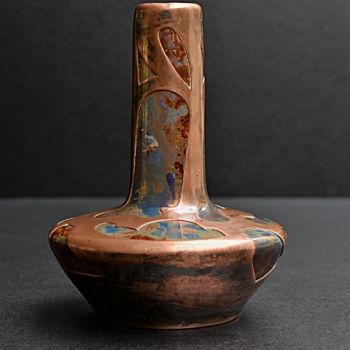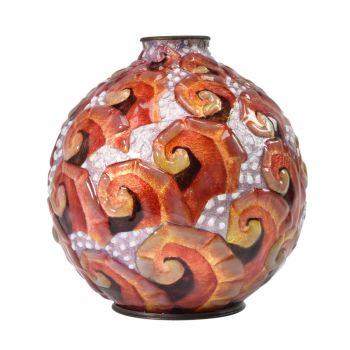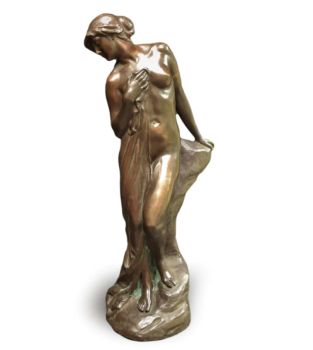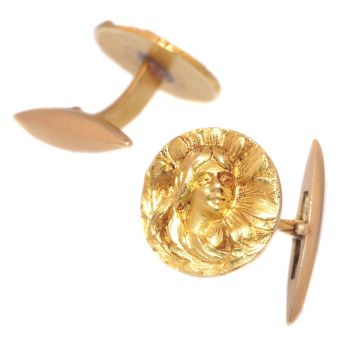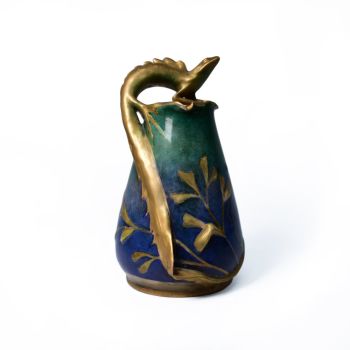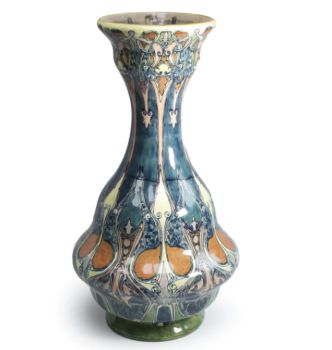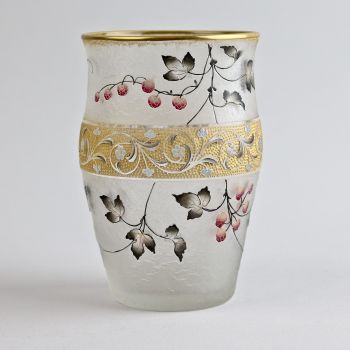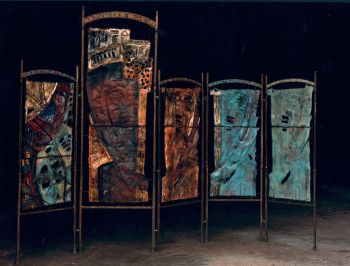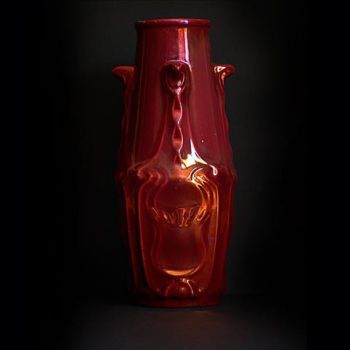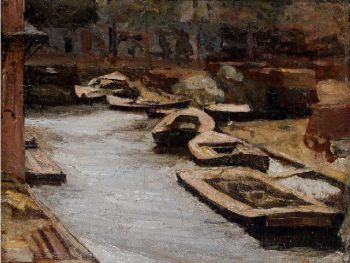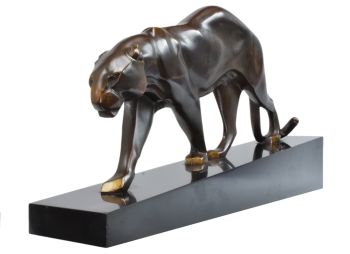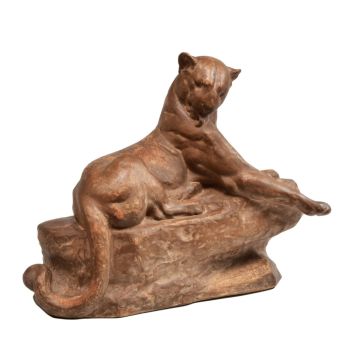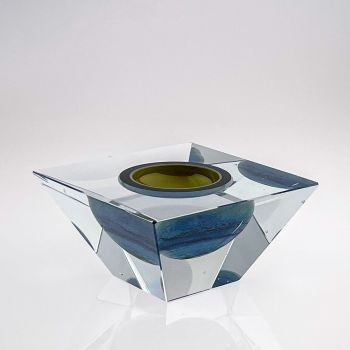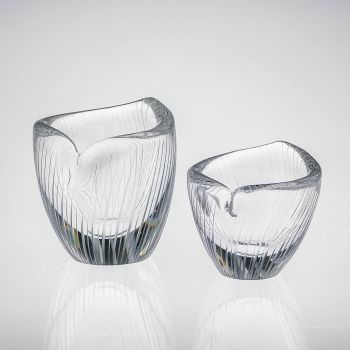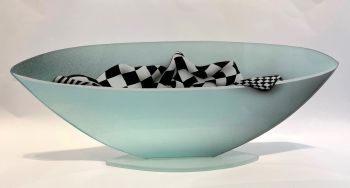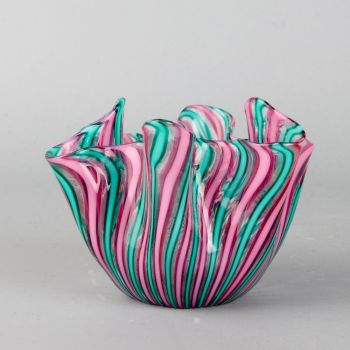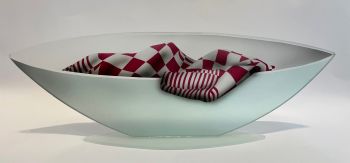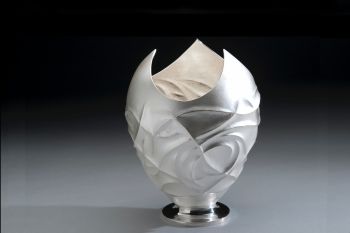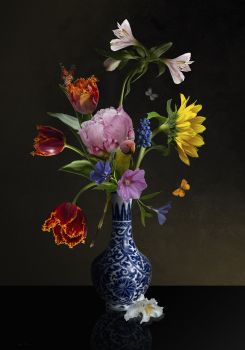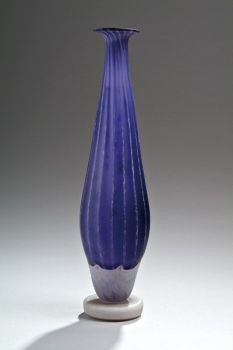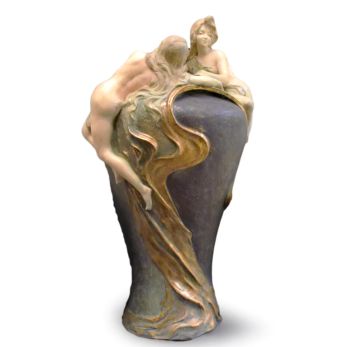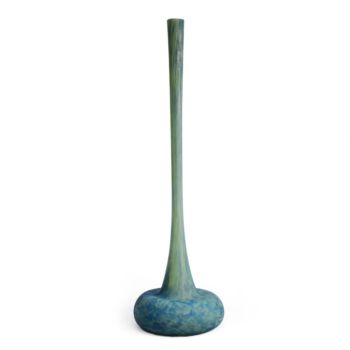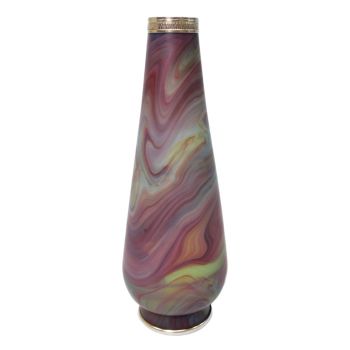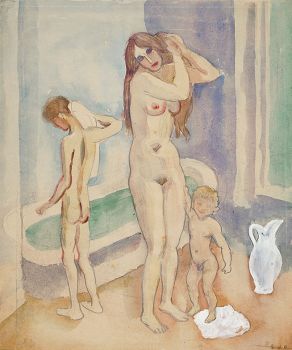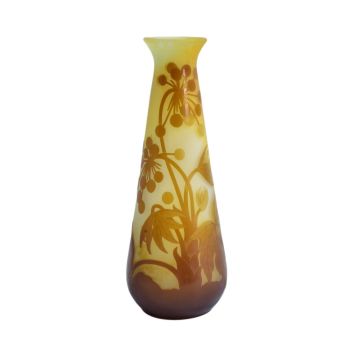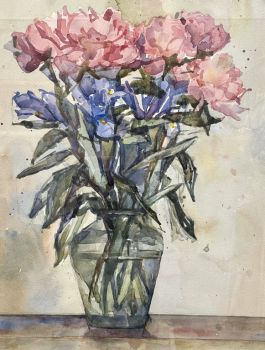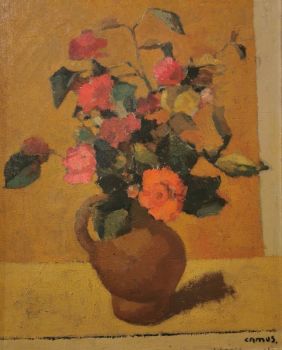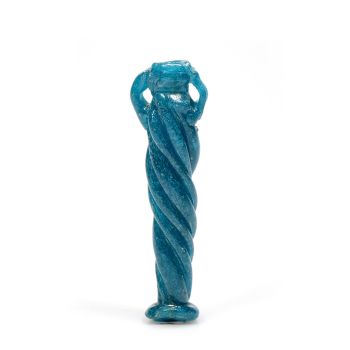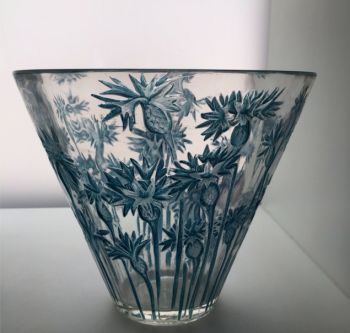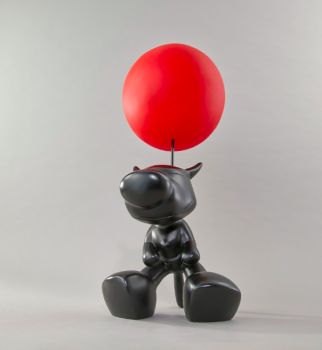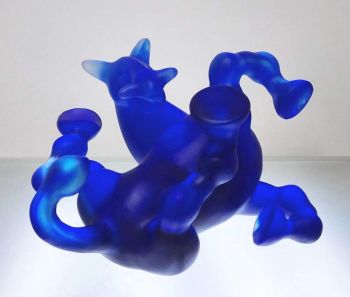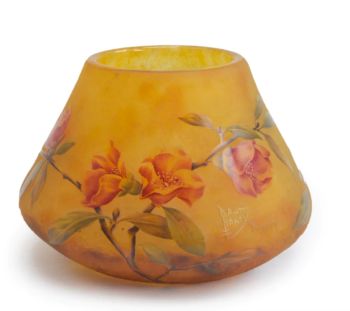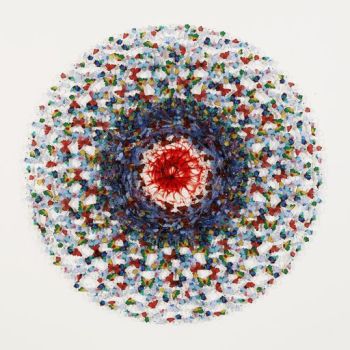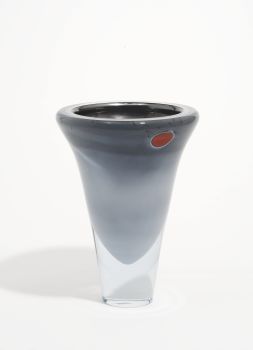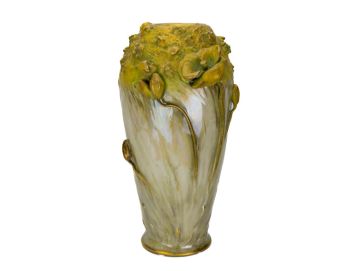Johann Loetz Witwe - Flamarion Titania bowl – Franz Hofstätter 1900 - 1910
Johann Loetz (Lötz) Witwe Klostermühle
Glas
8 cm, ø 10 cm
ConditionNear mint
Prijs op aanvraag
Antiques Emporium
- Over kunstwerkManufacturer: Johann Loetz Witwe
Decor: Flamarion
Style: Jugendstil
Material: Molded and free-formed glass, reduced, improved pontil
Color: Titania – blue with green flames
Period: 1900 – 1909
Description:
Franz Hofstätter’s work for Johann Loetz Witwe after 1900 is not entirely clear to this day. It occurs sporadically that a designer mentions his name on a design making attributions very difficult to trace. The reason of this could be that the produced glass was not immediately considered as very important art glass and therefor it was not needed to describe everything very detailed.
Our beautiful bowl is of the decor Flamarion and is a variation of the highly successful Titania genre that had been in production since 1905. Flamarion made its appearance in the year 1907 and can be attributed to the designer Franz Hofstätter. This attribution is substantiated by his name entry in the invoice book in the period 1908 – 1911 for the delivery of objects for the Exhibition “Österreichischer Kunstgewerbe” in Vienna 1911 / 1912.
The bowl is blown in light blue glass with silver titania glass threads in a crackle pattern with a decoration of drawn vertical green strips with silver titania threads in a flame pattern.
Literature:
Prestel – Böhmisch Glas 1880 – 1940 Band 1 Werkmonographie. Page 243.
Hatje Cantz – Lötz, Böhmisch Glas 1880 bis 1940. Page 88. - Over kunstenaar
Lötz/Loetz werd in 1840 opgericht door Johann Lötz en was een bedrijf gevestigd in Bohemen, in de Tsjechische Republiek, in de tijd dat Lötz tot het keizerrijk Oostenrijk-Hongarije behoorde. In 1879 nam een kleinzoon van Lötz, Max Ritter-Von Spaun, de zaak over van zijn grootmoeder en hield de naam Joh. Lötz Witwe.
Vanaf dat moment begon Johann Lötz Witwe echt naam te maken, ze ontwikkelden nieuwe innovatieve glastechnieken, maar ook hun vormgeving en felle kleuren waren helemaal vernieuwend. Ze ontwierpen bijzondere vormen en vazen, luxe artikelen, die ze verkochten in luxe winkels in Wenen, Berlijn, Hamburg, Parijs, Londen, Milaan, Brussel en Madrid. Het maakte ze al snel zeer bekend en beroemd.
Het was de periode dat de Art Nouveau of zoals dat in Duitsland Jugendstil genoemd werd, bloeide. Ze gebruikten organische vormen, de natuur was hun voorbeeld, ook voor Lötz ontwikkelden ze prachtige decors, gelijkend op vlindervleugels, zoals het papillondecor van deze vaas, vaak werden de vormen organisch gevormd door met een tang het hete glas ongelijk te vormen, evenals bloemen worden gevormd. Maar ook een octopus of zeeschelpen werden als voorbeeld genomen voor hun bijzondere vazen en decors.
Lötz nam deel aan allerlei Wereldtentoonstellingen, waaronder de beroemde Wereldtentoonstelling van 1900 in Parijs waar ze de Grote Prijs wonnen. Ze werden bekroond met tal van prijzen voor deelname aan Wereldtentoonstellingen. Max Ritter von Spaun ontving ook speciale onderscheidingen voor zijn bijdrage aan de glasindustrie, in 1883 mocht hij de keizerarend in hun schild en zegel gebruiken, ze mochten ook K.K. Zet Private Glass Factory voor hun naam. In 1889 ontving hij ook een ridderschap van Franz Josef. Maar ook andere koningshuizen waren erbij betrokken. Hij ontving de Belgische Leopoldsorde en het eervolle Franse Legion d'Honneur.
Hun ontwerpen vielen in de smaak, ook in de Verenigde Staten. Tiffany werkte met Lötz aan de set van Favril. Lötz patenteerde enkele van hun speciale technieken, zoals degene die ze gebruikten om het Phänomen-decor te maken. Ze waren in staat iriserend glas te maken. Kortom, Lötz was een begrip geworden. En dat is het nog steeds.
Lötz werkte ook nauw samen met andere glasfabrikanten zoals J.&L. Lobmeyer en E. Bakolowits Söhne in Wenen en met Argentor. Daarnaast werkte Lötz nauw samen met verschillende kunstenaars, zoals Josef Hoffmann, Koloman Moser, Franz Hofstötter, Michael Powolny en andere kunstenaars van de Wiener Werkstätte. Michael Powolny was verantwoordelijk voor de veel strakkere tangovazen uit de jaren twintig.
De Eerste Wereldoorlog en het einde van het Oostenrijkse rijk betekenden een moeilijke periode voor Lötz.
Lötz heeft bestaan tot 1940, na een bombardement is de fabriek volledig afgebrand. Na de Tweede Wereldoorlog behoorde Tsjechië tot de satellietstaten van de Sovjet-Unie, de fabriek werd genationaliseerd totdat deze uiteindelijk in 1947 werd gesloten.Het glas van Lötz is nog steeds erg populair en wordt wereldwijd verzameld, daarnaast is hun oeuvre ook terug te vinden in vele museumcollecties.
Bent u geïnteresseerd om dit kunstwerk te kopen?
Artwork details
Related artworks
Johann Loetz (Lötz) Witwe Klostermühle
Johann Loetz Witwe – Jugendstil Cobalt Papillon vaas1900 - 1910
Prijs op aanvraagAntiques Emporium
Johann Loetz (Lötz) Witwe Klostermühle
Johann Loetz Witwe - Phänomen Genre 7773 – Orange1900 - 1910
Prijs op aanvraagAntiques Emporium
1 - 4 / 7- 1 - 4 / 24
Amalric Walter
Amalric Walter & Henri Bergé – Crabe plumier1920 - 1929
Prijs op aanvraagAntiques Emporium
Gabriel Argy-Rousseau
Gabriël Argy-Rousseau – Crabes et Algues vase – 19201920 - 1929
Prijs op aanvraagAntiques Emporium
1 - 4 / 24Jan Sluijters
Moeder met twee kinderen in badkamer1900 - 1950
Prijs op aanvraagStudio 2000 Art Gallery
Johann Loetz (Lötz) Witwe Klostermühle
Johann Loetz Witwe - Phänomen Genre 7773 – Orange1900 - 1910
Prijs op aanvraagAntiques Emporium
Johann Loetz (Lötz) Witwe Klostermühle
Johann Loetz Witwe – Jugendstil Cobalt Papillon vaas1900 - 1910
Prijs op aanvraagAntiques Emporium
1 - 4 / 24Amalric Walter
Amalric Walter & Henri Bergé – Crabe plumier1920 - 1929
Prijs op aanvraagAntiques Emporium
Frères Daum
Daum Nancy – “Paysage Soleil Couchant” vase with two applied handles1900 - 1910
Prijs op aanvraagAntiques Emporium
Onbekende Kunstenaar
Gevleugelde Venetiaanse Beker1624 - 1626
Prijs op aanvraagPeter Korf de Gidts - Antiquairs
1 - 4 / 24Amalric Walter
Amalric Walter & Henri Bergé – Crabe plumier1920 - 1929
Prijs op aanvraagAntiques Emporium
Johann Loetz (Lötz) Witwe Klostermühle
Johann Loetz Witwe - Phänomen Genre 7773 – Orange1900 - 1910
Prijs op aanvraagAntiques Emporium
Johann Loetz (Lötz) Witwe Klostermühle
Johann Loetz Witwe – Jugendstil Cobalt Papillon vaas1900 - 1910
Prijs op aanvraagAntiques Emporium
1 - 4 / 12


















